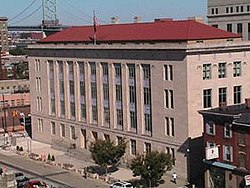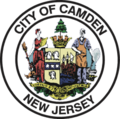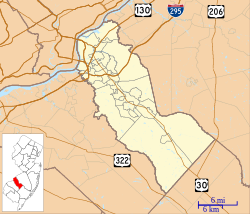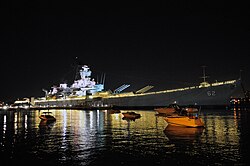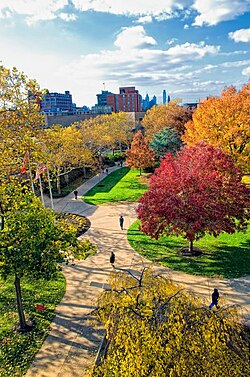Camden, New Jersey | |
|---|---|
| Motto: In a Dream, I Saw a City Invincible [1] | |
 Location of Camden in Camden County highlighted in red (right). Inset map: Location of Camden County in New Jersey highlighted in orange (left). | |
| Coordinates: 39°56′24″N75°06′18″W / 39.94°N 75.105°W | |
| Country | |
| State | |
| County | Camden |
| Settled | 1626 |
| Incorporated | February 13, 1828 |
| Named after | Charles Pratt, 1st Earl Camden |
| Government | |
| • Type | Faulkner Act (mayor–council) |
| • Body | City Council |
| • Mayor | Victor Carstarphen (D, term ends December 31, 2025) [3] [4] |
| • Administrator | Timothy J. Cunningham [5] |
| • Municipal clerk | Luis Pastoriza [6] |
| Area | |
• Total | 10.34 sq mi (26.78 km2) |
| • Land | 8.92 sq mi (23.10 km2) |
| • Water | 1.42 sq mi (3.68 km2) 13.75% |
| • Rank | 208th of 565 in state 7th of 37 in county [8] |
| Elevation | 16 ft (5 m) |
| Population | |
• Total | 71,791 |
| 71,749 | |
| • Rank | 532nd in country (as of 2023) [12] 14th of 565 in state 2nd of 37 in county [14] |
| • Density | 8,047.4/sq mi (3,107.1/km2) |
| • Rank | 50th of 565 in state 2nd of 37 in county [14] |
| Time zone | UTC−05:00 (Eastern (EST)) |
| • Summer (DST) | UTC−04:00 (Eastern (EDT)) |
| ZIP Codes | |
| Area code | 856 [17] |
| FIPS code | 3400710000 [8] [18] [19] |
| GNIS feature ID | 0885177 [8] [20] |
| Website | www |
Camden is a city in Camden County, in the U.S. state of New Jersey. It is part of the Delaware Valley metropolitan region. [21] The city was incorporated on February 13, 1828. [22] Camden has been the county seat of Camden County [23] since the county's formation on March 13, 1844. [22] The city derives its name from Charles Pratt, 1st Earl Camden. [24] [25] Camden is made up of over 20 neighborhoods, [26] [27] [28] and is part of the South Jersey region of the state.
Contents
- History
- Prehistory
- Settlement years (1623–1701)
- Colonial (1702–1775)
- Post-colonial (1776–1827)
- Founding and early years (1828–1890)
- Industrial growth (1891–1950)
- Industrial decline (1951–1991)
- Revitalization (1992–present)
- Culture
- Community
- Arts and entertainment
- Religion
- Philanthropy
- Economy
- Largest employers
- Urban enterprise zone
- Geography and architecture
- Neighborhoods
- Waterfront
- Port
- Housing
- Climate
- Education
- Public schools
- Charter and renaissance schools
- Private education
- Higher education
- Libraries
- Sports
- Camden Athletic Complex
- Philadelphia 76ers training facility
- Government
- Federal, state and county representation
- Politics
- Emergency Services
- Camden Fire Department (CFD)
- Camden County Police Department (CCPD)
- Crime
- Transportation
- Public transportation
- Roads and highways
- Environmental problems
- Demographics
- 2020 census
- 2010 census
- Points of interest
- In popular culture
- Notable people
- Actors and actresses
- Architects and artists
- Athletes
- Authors, poets and writers
- Military
- Musicians
- Politicians and public officials
- Other
- References
- External links
The initial growth of Camden industrially is often credited to the "big three" employers: RCA Victor, Campbell's Soup Company and New York Shipbuilding Corporation. The "big three" felt compelled to move away from Camden in the mid-to-late-20th century as they could find cheaper workers elsewhere. [29] [30] Though the city has declined in recent decades since the decline of heavy industry in the area and white flight to the suburbs, the city has made efforts to revitalize itself through various infrastructure and community projects.
Projects such as the redevelopment of the waterfront area brought three tourist attractions to the area: the Battleship New Jersey Museum and Memorial, the Freedom Mortgage Pavilion and the Adventure Aquarium. [31] The city is the home of Rutgers University–Camden, which was founded as the South Jersey Law School in 1926, [32] and Cooper Medical School of Rowan University, which opened in 2012. Camden also houses both Cooper University Hospital and Virtua Our Lady of Lourdes Hospital. Camden County College and Rowan University also have campuses in downtown Camden. The "eds and meds" institutions account for roughly 45% of Camden's total employment. [33]
Once known for violent crime, the restructuring of the police force in 2013 has been credited for its decline. As of January 2021, violent crime was down 46% from its high in the 1990s and at the lowest level since the 1960s. Overall crime reports in 2020 were down 74% compared to 1974, the first year of uniform crime-reporting in the city. [34]

